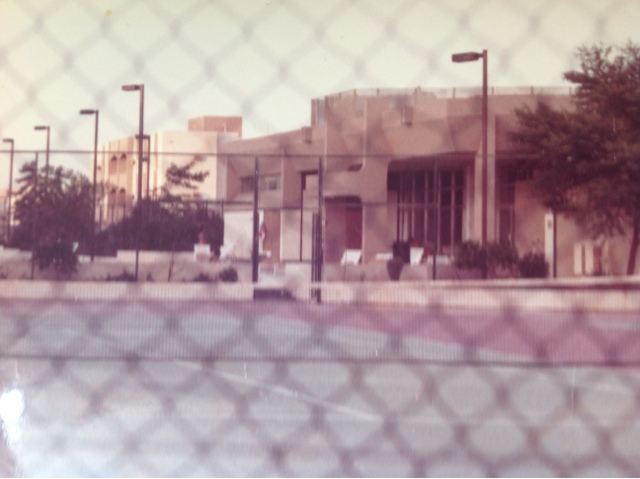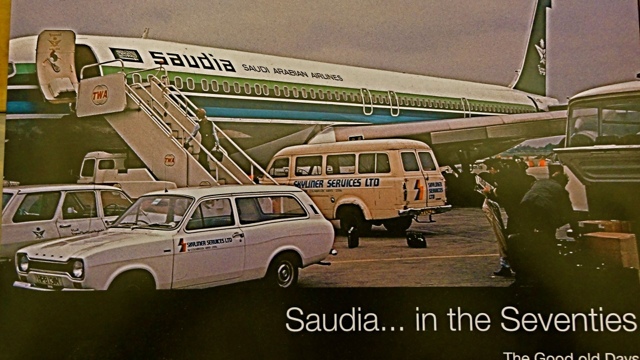zondag 14 november 2010
dinsdag 9 november 2010
My days with Saudi Arabian Airlines
Saudi Arabian Airlines commercials
Saudi Arabian Airlines commercial 2012
My days as a flight attendant in Saudi Arabia
Arrival
August, 1981 With a group of about 25 girls we boarded a Saudi Arabian Airlines Tristar L1011 at London Heathrow Airport - destination : Jeddah , Saudi Arabia
We were the new load of trainee-flight attendants. Most of the group was British, one Irish girl, one Scottisch girl. I was the only Dutch girl.
The flight took us way over Egypt and the Red Sea , when the sun was coming down. The view was absolutely ashtonishing, the sky was red. It looked beautiful. Flying over the Red Sea we reached Jeddah.
Getting off the plane, immediately we were struck by the humid heat, and the special scent, that I have only smelled in Saudi Arabia Saudia City
We had to check in at the office of the check-hostess on duty, a sort of manager of the compound, sign our names in a book, and we were given a number and apartment. The apartments were spacious, dark blue carpeted, with wooden furnture.The kitchen was large and we had two bathrooms, one with a bath, and one with bath and shower. Outside we had a large swimmingpool and tenniscourt, and place to play tabletennis.
The building had three floors. Above the three floors was a space for some washing and dryingmachines, and a door to the roof, were later during the year, we would spend many hours late at night, enjoying the view at the stars and the moon, and talking, and sometimes sunbathing during the day.
We had a small supermarket, and some other small stores within the compound.
The next day we started our 6 weeks training program.
We went to the trainingcentre to get acquainted with our teachers, the building, the training, and the classmates.
Downstairs we had a big restaurant, and upstairs were the trainingrooms, and some mock-ups of airplanes, where we had to our safety-practice later on.
We received our manuals. A safety manual and a manual with procedures.
The next day we had to pick up our uniforms and suitcase/beautycase. The uniforms were quite nice. We had several pairs of uniforms. One dark-blue skirt and jacket uniform, and one dark-blue trousers and jacket uniform, and one bourgondy skirt and jacket uniform. The two hats, completed it, one dark-blue hat, and one burgundy hat. We received our blouses with long and short sleeves, aprons, and a nice Samsonite burgundy suitcase and burgundy beautycase. And last but not least a nice burgundy long winter coat.
We were all very eager to be able to start wearing them.
The training was interesting. We received a lot of information about the different aircraft types. We would be working on several types of aircraft: the Boeing 737, the Boeing 707, and the Lockheed Tristar L1011. The Boeing 747 training we would take later.
We had safetytraning, service training, and grooming training.The safety training complied all kinds of emergency procedures and emergency events that could occur during take-off, landing and in-flight. We learned how to survive on a raft in the sea after a landing on sea, and how to extinguish different kind of fires on the plane. Our teachers were from different origins, Saudi, Egyptian, Lebanese, Moroccan, English, American, Indian and Australian. Also our classmates originated from many countries, mostly British though in my class. It was all very interesting and challenging for someone of 20 years old.
Besides our safety instructionlessons, our days were filled with lessons on how to serve meals and drinks in economy and first class, how to use the ovens/ stoves in the different aircraft, were oxygen bottles and fire-extinguisers were located on the different aircraft, and how to evacuate passengers in an emergency. On top of that we had First-Aid training. To prepare for a an evucuation of passengers, we went into the mock-up cabine, and pretended to be in an emergencysituation, in this case a fire on the plane. To create a very realistic setting, smoke was created, and we had to jump out of the aircraft on the inflatable slide, that was linked to the door and ended one floor down, on a special area constructed at the outside of the building, well protected by a wall and soft material, to train the right way to jump out a plane while evacuating.
In a swimmingpool we had to learn how to use the same slides,that were now converted into the raft, mentioned earlier. On the raft there would be room for many people. We learned how to seat them properly balanced, and we learned how to use the survival kit, how to use flares during day- and nighttime, and how to filter the salt out of water to make it drinkable. We learned about which procedures a pilot had to follow to perform an emergency landing on water, and on land, to evacuate the passengers away from where the wind could blow eventual fires in their direction, and more small, but significant technical details to heighten the safety of the people and increase their chances to survive an emergeny. In order to have everone leave the as fast as possible, positive, clear, short commands were to be given, not to give them a second thought of what to do.
Preparing for ditching
Jump and slide
Preparing for ditching
Jump and slide
Fortunately I had never had to bring any of this into practice during my flights, allthough we had some very minor incidents during flights, like severe turbulence and thunderstorms.
Finally the big day had arrived. The exams were well passed, and we were send on our first flight. Our check-flight. If we would pass this, we would officially be able to call ourselves airhostess and receive what they call, our wings, a small goldplated ornament which we attached to the jacket of our uniform.
Our checkflight took us to Karachi in Pakistan
After our checkflight we flew on regular schedules. Each month we could choose a so called flying partner, with whom we shared the same flights. At the start, mainly we did domestic flights inside of Saudi Arabia Dubai , Abu Dhabi and Qatar and Yemen , and did we fly to Damascus in Syria , Khartoum in Sudan , and Cairo in Egypt Saudi Arabia Paris , London , Bangkok , New York , Athens
The compound
The compound
Inside our apartment
The compound we lived in was quite nice too, and after getting used to the Saudi culture, life was quite fascinating and interesting in Jeddah. Friendships were developed with the local people and people from all over the world, Saudi Arabia being a very international country. The social life for us, the cabin crew, was taking place, mostly at private gatherings, at people's houses, or by the Creek, by the Red Sea, or by frequenting the big hotels and various restaurants and shoppingmalls around the city.
In our compound we had a swimmingpool and tenniscourt. It was well cared for, even the flowers and plants were growing well there.
The compound was a part of Saudia city, a village or city build to accomodate the foreign employees of Saudia. It existed of various compounds, like the family compound, the hostess compound and steward compound. The hostess compound was divided in the old - and new hostess compound. The new hostess compound hosted the permanent hostesses that were Jeddah base and new trainees, and old hostess compound the outside base crew during their layover in Jeddah.
View over the wall that surrounded the new hostess compound into the family compound, with the water tower in Saudia colours,green, white and blue.
The rooms were airconditioned, so the temperature inhouse was very pleasant. A very nice detail was that we had cleaners that came around each morning, 6 days a week. They made our beds, too.
The kitchen was spacious, with brown plates and cups and equiped with a stove with oven. We ironed our clothes here too.
This building was next to the entrance with reception area, and also the office of the checkhostess on duty. The blue bus was the crewbus that transported the hostesses to the airport.
On the topfloor of the building, a laundry room with washing machine and dryer, was made available to us. On our television we had access to a filmchannel displaying movies from the west, plus access to the local tv channels, which was good to help us improve our arabic. In the months flying VIP flights, often you could see the plane you worked on in the local newsbroadcasting, showing a minister, or the King disembarking the plane on the way to one of the many conferences that were held in Saudi Arabia. Also many foreign heads of state and important ministers visited Saudi Arabia.
Carlos Reutemann driving Formule 1 for the Saudia/Williams team 1980
In the eighties Saudi Arabian Airlines was one of the sponsors of the Formula one racing
team of Williams. Carlos Reutemann, from Argentina and Alan Jones were the drivers of the team.
Saudia, the fleet
The fleet
The fleet in 1981.
In 1981, the days that I started off the work as a Flight attendant for Saudi Arabian airlines, we had several nice airplanes on which we received safety and service training of.
We had the Boeing 747, 707 and 737. The Lockheed Tristar L1011, the cargo planes and the Royal Fleet consisting of several Gulfstream II's and two Boeing 737's with adapted seat configuration and interior apt to serve flights for government officials and the Royal family. On top of that a Boeing 747 SP was converted into a flying palace almost, equiped with even an operation room with an hydraulic operationtable to work on even during turbulence. In the seat of the king a special device had been installed that could measure the heart rate of the King and was directly connected with the famous Mayo Clinic in Cleveland, Ohio in the US. The registration of this plane was HM 1, His majesty one. The Royal Boeing 737's had the registtration code HM2 and HM3.
The commercially used aircraft had a registration code that started with HZ.
The fleet in 2012
The nowadays fleet consists of Boeings and Airbusses mainly. Saudia has a Beoing 777, Boeing 737, Boeing 747, Airbus 320-200, Airbus 333, and MD90 and the Embraer 170.
Abonneren op:
Posts (Atom)















